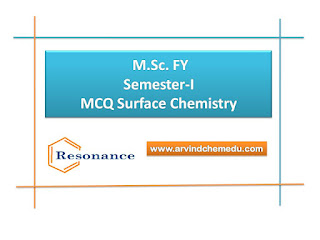M.Sc. First year Postgraduate degree course Semester First Physical Chemistry paper CHE-104
Chapter – Surface Chemistry
Multiple Choice questions
a) Carboxylate
b) Tween
c) Ampholytic elements
d) Surfactants
a) CMC
b) Micelle
c) Polarity
d) Non-polarity
a) Mars
b) Kraft
c) Kraffin
d) Curtis
a) Anionic
b) Cationic
c) Amphoteric
d) Non-ionic
5. ---------- are the compound that lowers the surface tension between two liquids or between a liquid and a solid.
a) Reverse micelles
b) Surface active agent
c) Counter ion
d) Catalyst
6.What is the molecular formula of stearate ion?
a) C17H35COO–
b) C35H17COO+
c) C35H17COO–
d) C17H35COO+
7.Which part of the stearate ion is hydrophilic in nature?
a) Tail
b) Hydrocarbon chain
c) Head
d) None of the mentioned
8. Which of the following is water insoluble?
a) COO–
b) Na+
c) C17H35
d) All of the mentioned
9.Select the incorrect statement from the following options.
a) In the micelle formation, the water soluble heads are directed towards the centre
b) In the micelle formation, the water soluble heads are on the surface in contact with the water
c) In the micelle formation, the water insoluble tails are directed towards the centre
d) None of the mentioned
10.The transition of ions to micelle is ___________
a) Reversible
b) Irreversible
c) All of the mentioned
d) None of the mentioned
11.What is Critical Micelle Concentration?
a) The maximum amount of concentration that is required for the formation of micelle
b) The minimum amount of concentration that is required for the formation of micelle
c) The maximum amount of concentration that is not required for the formation of micelle
d) The minimum amount of concentration that is not required for the formation of micelle
12.Micelles behave as colloids only when?
a) Concentration is less than CMC
b) Concentration is equal to CMC
c) Concentration is greater than CMC
d) They always behave as colloids
13. The conductivity of micelles is ___________
a) Higher than a colloidal solution
b) Lower than a colloidal solution
c) Equals to colloidal solution
d) None of the mentioned
14. The size of counter-ions increases CMC….
a) Decreases
b) Increases
c) Remains same
d) Not any change
a) Decreases
b) Increases
c) Remains same
d) Not any change
a) Decreases
b) Increases
c) Remains same
d) Not any change
a) Conductivity measurement
b) Surface tension
c) Both a and b
d) None of these
a) One ion is colloidal size
b) Both ions are colloidal size
c) Small size ions
d) None of these
a) Aqueous solvents
b) Organic solvents
c) Non aqueous solvents
d) Both b and c
a) Mass action model
b) Phase separation model
c) Both a and b
d) None of these
More study Material for M.Sc. First Year (First Semester)
CHE-101 Analytical Chemistry
Analytical chemistry unit-1 MCQ
Analytical chemistry unit-2 MCQ
Analytical chemistry unit-3 MCQ
Chromatography mcq Part-1
Chromatography mcq Part-2
Chromatography Mcq Part-3
CHE-104 Physical Chemistry
Chemical dynamics Part-I pdf notes
Chemical dynamics Part-II pdf notes
Surface Chemistry Handwritten notes pdf Part-I
Surface Chemistry Handwritten notes pdf Part-II
Surface Chemistry MCQ
Surface Chemistry Handwritten notes pdf Part-III
CHE-103 Organic Chemistry
Organic Chemistry paper CHE-103; Practice Set (1,2,3) M.Sc. First year
Organic Chemistry paper CHE-103; Practice Set (4) M.Sc. First year
Organic Chemistry paper CHE-103; Practice Set (5) M.Sc. First year








